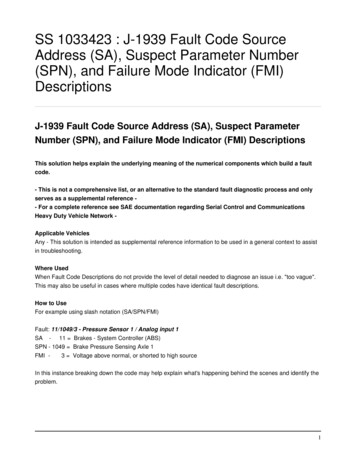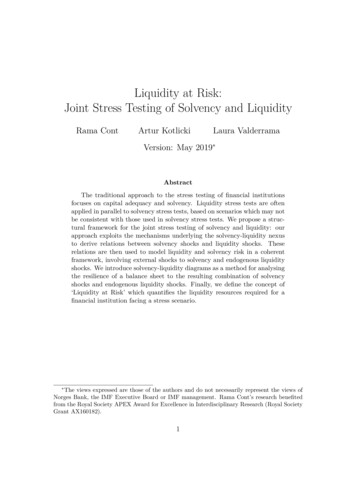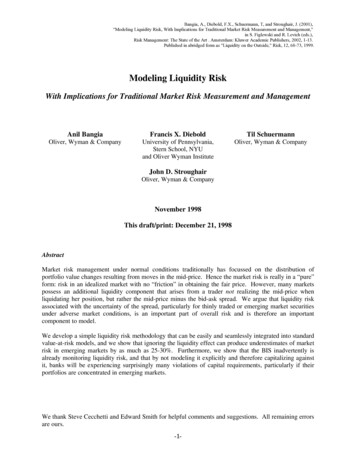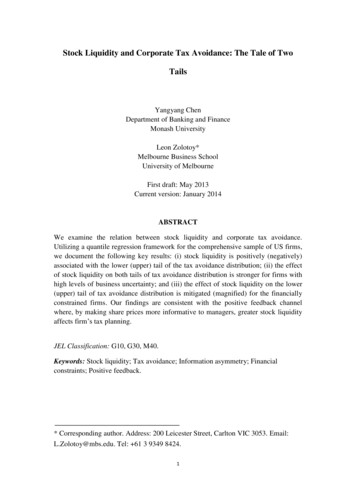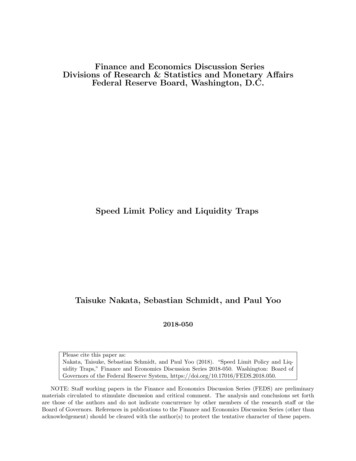
Transcription
Finance and Economics Discussion SeriesDivisions of Research & Statistics and Monetary AffairsFederal Reserve Board, Washington, D.C.Speed Limit Policy and Liquidity TrapsTaisuke Nakata, Sebastian Schmidt, and Paul Yoo2018-050Please cite this paper as:Nakata, Taisuke, Sebastian Schmidt, and Paul Yoo (2018). “Speed Limit Policy and Liquidity Traps,” Finance and Economics Discussion Series 2018-050. Washington: Board ofGovernors of the Federal Reserve System, https://doi.org/10.17016/FEDS.2018.050.NOTE: Staff working papers in the Finance and Economics Discussion Series (FEDS) are preliminarymaterials circulated to stimulate discussion and critical comment. The analysis and conclusions set forthare those of the authors and do not indicate concurrence by other members of the research staff or theBoard of Governors. References in publications to the Finance and Economics Discussion Series (other thanacknowledgement) should be cleared with the author(s) to protect the tentative character of these papers.
Speed Limit Policy and Liquidity Traps Taisuke Nakata†Federal Reserve BoardSebastian Schmidt‡European Central BankPaul Yoo§UNC Kenan-FlaglerFirst Draft: January 2018This Draft: June 2018AbstractThe zero lower bound (ZLB) constraint on interest rates makes speed limit policies(SLPs)—policies aimed at stabilizing the output growth—less effective. Away from theZLB, the history dependence induced by a concern for output growth stabilization improves the inflation-output tradeoff for a discretionary central bank. However, in theaftermath of a deep recession with a binding ZLB, a central bank with an objective foroutput growth stabilization aims to engineer a more gradual increase in output thanunder the standard discretionary policy. The anticipation of a more restrained recoveryexacerbates the declines in inflation and output when the lower bound is binding.Keywords: Liquidity Traps, Markov-Perfect Equilibrium, Speed Limit Policy,Zero Lower Bound.JEL-Codes: E52, E61 This paper was prepared in part while Taisuke Nakata was a visiting scholar at the Institute of MonetaryStudies (IMES) of the Bank of Japan (BOJ), whose hospitality is gratefully acknowledged. We thank seminarparticipants at the Bank of Japan and the University of Tokyo for comments and suggestions. We also thankShigenori Shiratsuka, Youichi Ueno and an anonymous referee for the IMES Discussion Paper Series for usefulsuggestions and Katherine Arnold for editorial assistance. Philip Coyle, Philipp Lieberknecht, and JonathanYu provided excellent research assistance. The views expressed in this paper, and all errors and omissions,should be regarded as those solely of the authors and are not necessarily those of the Bank of Japan, theFederal Reserve Board of Governors, the Federal Reserve System, or the European Central Bank.†Board of Governors of the Federal Reserve System, Division of Research and Statistics, 20th Street andConstitution Avenue NW, Washington, D.C. 20551; Email: taisuke.nakata@frb.gov.‡European Central Bank, Monetary Policy Research Division, 60640 Frankfurt, Germany; Email: sebastian.schmidt@ecb.int.§UNC Kenan-Flagler Business School (CB 3490, McColl Building), 300 Kenan Center Dr., Chapel Hill,NC 27599; Email: paul yoo@kenan-flagler.unc.edu
1IntroductionEconomists have long studied the efficacies of various monetary policy strategies. Severalstudies on the design of monetary policy have emphasized the desirability of central bankobjectives that assign a role to the stabilization of output growth. First and foremost,a seminal paper by Walsh (2003) demonstrated that, in standard sticky-price models, adiscretionary central bank that is concerned with stabilization of inflation and output growth,rather than output, improves welfare by creating endogenous inertia in the interest ratepolicy that is akin to the inertia observed under the optimal commitment policy. Othersmade a similar point by showing that interest rate feedback rules involving an output growthstabilization term can generate economic outcomes similar to those achieved under optimalcommitment policy in various sticky-price models (Blake (2012); Giannoni and Woodford(2003); Stracca (2007)). These policies that aim to reduce output growth volatility areknown as speed limit policies (SLPs).In this paper, we revisit the desirability of SLPs in an economy with an occasionallybinding zero lower bound (ZLB) constraint on nominal interest rates. Following Walsh (2003),we conduct our analyses in the context of policy delegation where the discretionary centralbank’s objective function is modified to include an output growth stabilization motive.1,2 Ourmodel features both demand and cost-push shocks. In the model without the ZLB constraint,the presence of the cost-push shock makes it desirable to assign a strictly positive weight tothe output growth stabilization motive, as shown by Walsh (2003). The presence of thedemand shock would have no implication for the desirability of SLPs when we abstract fromthe ZLB constraint because the demand shock can be fully neutralized by the adjustment inthe policy rate regardless of whether or not the central bank pursues a SLP. However, in themodel with the ZLB, a sufficiently large negative demand shock forces the central bank toreduce the policy rate to the ZLB, causing inflation and the output gap to decline. In thiscase, demand disturbances are no longer inconsequential for the assessment of SLPs.Our main exercise is to compare the desirability of SLPs in the models with and withoutthe ZLB constraint. We begin our analysis with a stylized model in which the cost and benefitof the SLP can be transparently described. We then move on to a richer model calibrated tomatch key features of the U.S. economy to examine the quantitative relevance of SLP.Our main finding is that the optimal weight on the output growth stabilization term issmaller in the model with the ZLB constraint than in the model that abstracts from theconstraint. The ZLB constraint makes SLPs less desirable because the central bank under aSLP acts in a way that is almost a polar opposite of what the central bank would do under1A key insight of the literature on policy delegation is that delegating policy to an agent with a differentobjective function than society can help to solve time inconsistency problems and improve welfare. Prominentexamples in the context of monetary policy include Rogoff (1985), Persson and Tabellini (1993), Walsh (1995),Walsh (2003), and Svensson (1997).2In Appendix F, we examine the desirability of SLPs in the context of a modified interest-rate feedbackrule and show that key results of the paper are robust to this alternative approach.2
the optimal commitment policy. Under the optimal commitment policy, the central bankkeeps the policy rate low for long with the explicit goal of overshooting inflation and theoutput gap above their longer-run targets. The overshooting of inflation and the output gapin the future mitigates the declines in inflation and the output gap while the ZLB is a bindingconstraint through improved expectations.Under the SLP, the central bank has an incentive to raise the policy rate more rapidly inthe aftermath of a crisis than it does under the standard discretionary policy in order to keepthe output gap close to the low level that prevailed during the crisis. Since households andfirms are forward-looking, the expectations of low output gap and low inflation associatedwith it amplify the declines in inflation and the output gap at the ZLB constraint.The extent to which the ZLB constraint reduces the optimal weight on the output growthstabilization term depends on the specifics of the model under investigation. In the stylizedmodel, the optimal weight on the output growth term becomes smaller when the ZLB constraint is accounted for, but remains strictly positive under all parameter values we considerin this paper. In the quantitative model calibrated to match key features of the U.S. economy,we find that the optimal weight is zero in the model with the ZLB, while it is positive in themodel without the ZLB.This paper builds on previous studies that have examined the desirability of SLPs insticky-price models. As mentioned in the introductory paragraph, the benefits of SLPsarising from its ability to generate desirable history dependence in the policy rate havebeen documented by several studies (Blake (2012); Giannoni and Woodford (2003); Stracca(2007); Walsh (2003)).3 Others have emphasized the desirability of SLP in models wherethe target variable—be it the output gap or unemployment gap—is measured with errors.Examples are Orphanides, Porter, Reifschneider, Tetlow, and Finan (2000), Orphanides andWilliams (2002), and Orphanides and Williams (2007). In such models with measurementerrors, policies aimed at reducing the volatility of the mismeasured target variable can causea higher-than-intended volatility in the policy rate, which in turn leads to higher volatilitiesof inflation and the output gap. All these papers, however, abstract from the ZLB constraint:our contribution is to examine the desirability of speed-limit policy in models with the ZLBconstraint.The message of our paper echoes those of Blake, Kirsanova, and Yates (2013) and Brendon,Paustian, and Yates (2013) which provide caveats to speed-limit policies in different setups.Blake, Kirsanova, and Yates (2013) show that, when a persistent endogenous variable—suchas capital—is introduced into an otherwise standard New Keynesian model without the ZLB,there are multiple equilibria under the standard discretionary policy. They find that SLPsoften improve welfare in one equilibrium, but worsen welfare in another. Brendon, Paustian,and Yates (2013) examine the desirability of adding an output growth stabilization term in aninterest rate feedback rule in the New Keynesian model with the ZLB constraint. They find3See Bilbiie (2014) and Bodenstein and Zhao (2017) for more recent contributions.3
that the combination of SLP and the ZLB constraint can generate belief-driven recessions.Our analysis is different from Blake, Kirsanova, and Yates (2013) because our result doesnot require the presence of any endogenous state variables and our analysis features the ZLBconstraint. Our analysis differs from Brendon, Paustian, and Yates (2013) because we assumethe central bank is optimizing, as opposed to following an interest-rate feedback rule, and wefocus on recessions driven by fundamental shocks.Finally, this paper is related to a set of papers that consider policy delegation approachesto mitigate the adverse consequences of the ZLB under the discretionary central bank. Nakataand Schmidt (2014) demonstrate that the appointment of an inflation-conservative centralbanker is welfare-improving, as it mitigates the deflationary bias problem facing the discretionary central bank in the economy with occasionally binding ZLB constraint. Billi (2013)shows that modifying the central bank’s objective function to include a nominal-incomestabilization objective or a price-level stabilization objective can improve welfare, as bothframeworks generate a form of history dependence that is similar to the history dependenceattained under the optimal commitment policy. Finally, Nakata and Schmidt (2016) showthat it is welfare-improving to assign an interest rate smoothing objective to the centralbank, as the desire to smooth the path of interest rates creates a desirable history dependence, leading the central bank to keep the policy rate low for long in the aftermath of arecession. Our work is a useful reminder that introducing history dependence per se does notimprove welfare; one needs the right kind of history dependence.As the U.S. economy and monetary policy normalize, there is a growing interest in reexamining monetary policy strategies when the policy rate is subject to the ZLB (see, forexample, Williams (2017)). Accordingly, a careful re-examination of how policy strategiesknown to perform well in the economy without ZLB would perform once the ZLB is takeninto account is as relevant as ever. Although there are a growing number of papers on thisquestion of how to best conduct monetary policy in the presence of the ZLB constraint, sofar there is no paper examining how SLP performs in the model with ZLB. Thus, our paperfills in an important gap in the literature.The rest of the paper is organized as follows. Section 2 describes the stylized modeland formulates the problem or the central bank. Section 3 presents the results on how theZLB constraint alters the desirability of SLPs. Section 4 extends the analysis to a calibratedquantitative model. Section 5 concludes.2The modelThis section presents the model, lays down the policy problem of the central bank and definesthe equilibrium.4
2.1Private sectorThe private sector of the economy is given by the standard New Keynesian structure formulated in discrete time with infinite horizon as described in detail in Woodford (2003) and Gali(2015). A continuum of identical, infinitely-living households consumes a basket of differentiated goods and supplies labor in a perfectly competitive labor market. The consumptiongoods are produced by firms using (industry-specific) labor. Firms maximize profits subjectto staggered price-setting as in Calvo (1983). Following the majority of the literature on theZLB, we put all model equations except for the ZLB constraint in semi-loglinear form.The equilibrium conditions of the private sector are given by the following two equations:πt κyt βEt πt 1 et(1)yt Et yt 1 σ (it Et πt 1 rtn ) ,(2)where πt is the inflation rate between periods t 1 and t, yt denotes the output gap, it isthe level of the nominal interest rate between periods t and t 1, rtn is an exogenous naturalreal rate of interest, and et is an exogenous cost-push shock. Equation (1) is a standard NewKeynesian Phillips curve and equation (2) is the Euler equation. Parameters satisfy β (0, 1)and σ, κ 0.4We assume that the natural real rate follows a two-state Markov process. In particular,rtnn or r n where we refer to r n 0 as the high (non-crisis) statetakes the value of either rHHLn 0 as the low (crisis) state. The transition probabilities are given byand rLnn nnProb(rt 1 rL rt rH) pH(3)nn nnProb(rt 1 rL rt rL) pL .(4)pH is the probability of moving to the low state in the next period when the economy is inthe high state today and will be referred to as the frequency of the contractionary shocks.pL is the probability of staying in the low state when the economy is in the low state todayand will be referred to as the persistence of the contractionary shocks. We will also refer tohigh and low states as non-crisis and crisis states, respectively.We assume that the cost-push shock et follows a three-state Markov process, taking eH ,eM , and eL . For simplicity, we now assume that the process is independent and the probabilityof each state is identical. In other words, Prob(et 1 ei et ej ) 1/3 for any i and j in{H, M, L}. For simplicity, we also assume the shock is symmetric in size. That is, eH c,eM 0, and eL c where c is the magnitude of the cost-push shock. In Appendix A, weshow the robustness of our result in a version of the stylized model in which the demand andcost-push shocks follow AR(1) processes. κ is related to the structural parameters of the economy as follows: κ (1 α)(1 αβ)σ 1 η , whereα(1 ηθ)α (0, 1) denotes the share of firms that cannot reoptimize their price in a given period, η 0 is the inverseof the elasticity of labor supply, and θ 1 denotes the price elasticity of demand for differentiated goods.45
2.2Society’s objective and the central bank’s problemWe assume that society’s value, or welfare, at time t is given by the expected discounted sumof future utility flows,Vt u(πt , yt ) βEt Vt 1 ,(5)where society’s contemporaneous utility function, u(·, ·), is given by the standard quadraticfunction of inflation and the output gap,u(π, y) 1 2π λy 2 .2(6)This objective function can be motivated by a second-order approximation to the household’spreferences. In such a case, λ is a function of the structural parameters and is given byλ κ/θ.The value for the central bank is given byCBVtCB uCB (πt , yt , yt 1 ) βEt Vt 1.(7)where the central bank’s contemporaneous utility function, uCB (·, ·), is given byuCB (πt , yt , yt 1 ) 1 2πt λyt2 α(yt yt 1 )2 .2(8)Note that the central bank’s objective function has the output growth stabilization termα(yt yt 1 )2 in addition to the inflation and output stabilization terms.5 We assume thatthe central bank does not have a commitment technology. When α 0, the central bank’scontemporaneous utility function is identical to that of the society. We will refer to theoptimal discretionary policy associated with α 0 as the standard discretionary policy.Each period t, the central bank chooses the inflation rate, the output gap, and the nominalinterest rate in order to maximize its objective function subject to the behavioral constraintsof the private sector, with the policy functions at time t 1 taken as given. The problem ofthe central bank is thus given byVtCB (rtn , et , yt 1 ) maxπt ,yt ,itCB nuCB (πt , yt , yt 1 ) βEt Vt 1(rt 1 , et 1 , yt ).(9)subject to the ZLB constraint,it 0,(10)and the private-sector equilibrium conditions (1) and (2) described above.A Markov-Perfect equilibrium is defined as a set of time-invariant value and policy functions {V CB (·), y(·), π(·), i(·)} that solves the central bank’s problem above, together with5In Walsh (2003), the central bank’s objective function is modified so that the output growth stabilizationterm replaces the output stabilization term. We choose to keep the output stabilization term because, bydoing so, the central bank’s objective function nests the society’s objective function and thus the mechanismis clear.6
society’s value function V (·), which is consistent with y(·) and π(·).The main exercise of the paper will be to examine the effects of α on welfare. We quantifythe welfare of an economy by the perpetual consumption transfer (as a share of its steadystate) that would make a household in the economy indifferent to living in the economywithout any fluctuations. This is given byW : (1 β) θ 1σ η E[V ].κ(11)where the mathematical expectation is taken with respect to the unconditional distributionof dt and yt 1 .2.3Parameter values and solution methodsParameter values for the stylized model are shown in Table 1. The values for the model’sbehavioral parameters are from Woodford (2003). The parameters governing the shock processes are chosen to illustrate the key forces of the model in a transparent way. We willconduct sensitivity analyses with respect to key parameters at the end of Section 3.Table 1: Parameter Values for the Stylized 40.0030.01-0.0150.0050.50.15Economic interpretationSubjective discount factorInterest-rate elasticity of outputSlope of the Phillips curveWeight on the output stabilization termNatural-rate shock in the high stateNatural-rate shock in the low stateFrequency of contractionary demand shockPersistence of contractionary demand shockMagnitude of cost-push shocksWe solve the model by a variant of the standard time-iteration method that is modifiedto take it into consideration that the partial derivatives of future policy functions show upin the system of nonlinear equations characterizing the model’s equilibrium conditions. Thedetails of the solution method and the solution accuracy are described in Appendix B and C,respectively.3ResultsThis section describes how the introduction of an output growth objective affects welfare andthe propagation of economic shocks in the models with and without the ZLB.7
3.1Welfare effects of speed-limit policiesDashed and solid black lines in Figure 1 show how the welfare of the economies with andwithout the ZLB depends on the weight on the output growth stabilization term, respectively.Figure 1: Output Growth Stabilization and Welfare in the Stylized Model with the ZLB-0.025Welfare-0.03-0.035Model without ZLBModel with ZLB-0.04012345α 10-3Weight on the output growth stabilization termNote: The dashed and solid black lines show how welfare as defined in equation 11 varies with the relativeweight on the output growth objective in the model with and without the ZLB, respectively. The dashedand solid vertical black lines show the optimal weights from the model with and without the ZLB constraint,respectively.According to the figure, while putting some weight on the output growth stabilizationterm increases welfare in both economies with and without the ZLB, the optimal weight onthe output growth stabilization term is smaller in the model with the ZLB than in the modelwithout it. Also, the resulting welfare gain is smaller in the model with the ZLB than in themodel without it.To understand why the ZLB makes the SLP less effective, left and right columns of Figure2 show how the economy with the ZLB constraint responds to a positive cost-push and anegative natural rate shock—lasting for one period—under alternative assumptions aboutmonetary policy, respectively. In each figure, solid black, dashed red, and dash-dotted bluelines show the impulse response functions under the standard discretionary policy (SDP), thespeed limit policy (SLP) with α 0.003, and the optimal commitment policy (OCP).63.2Benefits of Speed Limit PolicyAccording to the left column of Figure 2, under the SDP—shown by the solid black lines—thecentral bank raises the policy rate at the time of the positive cost-push shock. After the shockis gone, the policy rate, inflation and the output gap immediately return to their steady-state6The formulation of the central bank’s problem under commitment is standard and is described in Appendix E.8
Figure 2: Impulse Responses in the Stylized Model(One-Period Cost-Push and Natural Rate Shocks)Cost-push shock8648Policy Rate(Ann. %)Speed-Limit Policy(SLP)Optimal CommitmentPolicy (OCP)Standard DiscretionaryPolicy (SDP)10Policy Rate(Ann. %)Natural rate shock242005100510051005105100.5Inflation(Ann. %)0.4Inflation(Ann. %)60.20-0.20-0.5-1-1.505102OutputGap (%)OutputGap (%)0-0.5-1-2-4-6051014OutputGrowth (%)OutputGrowth (%)0020-2-4-10510Time0TimeNote: “Standard Discretionary Policy (DSP)” shows the dynamics of the economy with the discretionarycentral bank with α 0 and “Speed Limit Policy (SLP)” shows the dynamics of the economy with thediscretionary central bank with α 0.003. “Optimal Commitment Policy (OCP)” shows the dynamics of theeconomy under the optimal commitment policy.values. Under the OCP—shown by the dash-dotted blue lines—the central bank raises thepolicy rate by less at the time of the shock and lowers the policy rate gradually to its steadystate thereafter. Consistent with this policy path, the output gap is negative and inflationundershoots its long-run target level after the positive cost-push shock disappears. The futureinflation undershooting improves the inflation-output tradeoff for the central bank in the first9
period through expectations. As a result, both the rise in inflation and the fall in the outputgap in the initial period are smaller under the OCP than under the SDP. The benefit ofmore stable inflation and output in the first period dominates the less-stabilized inflationand output afterwards in terms of welfare. This welfare gain from policy commitment insticky-price models with a cost-push shock is well known in the literature (Woodford (2003)and Gali (2015)).Under the SLP—shown by the dashed red lines—the policy rate path is qualitativelysimilar to that under the OCP; the central bank raises the policy rate initially by less than itwould under the standard discretionary policy and lowers it gradually to its steady-state valueafterwards. Output declines less than under the SDP in the first period and gradually returnsto its steady state. This path of the output gap leads to a small temporary undershootingof inflation from the second period on, with the initial increase in inflation being aboutthe same as that under the standard discretionary policy. With the inflation path roughlyunchanged from the SDP, but the output gap path substantially more stabilized, the welfarecosts associated with cost-push shocks are smaller under the SLP than under the SDP. Thisbeneficial effect of the SLP in response to a cost-push shock was first pointed out by Walsh(2003) and is present in both the model with the ZLB and the model without the ZLB.3.3Costs of Speed Limit PolicyWe now turn to the right column of Figure 2 which shows how the economy with the ZLBresponds to a negative demand shock. Under the SDP—shown by the solid black lines—thecentral bank keeps the policy rate at the ZLB as long as the crisis shock lasts, and inflationand output return to their steady-state values immediately after the crisis shock disappears.Under the OCP—shown by the dash-dotted blue lines—the central bank keeps the policy rateat the ZLB for two extra periods after the crisis shock is gone, which generates a temporaryovershooting of inflation and output above their long-run targets. Since households and firmsare forward-looking, the anticipation of the overshooting mitigates the declines in inflationand output while the policy rate is constrained at the ZLB. These dynamics of the economyunder the SDP and the OCP just described have been studied by many, most notably byEggertsson and Woodford (2003).Under the SLP—shown by the dashed red lines—the policy rate path in the aftermath of acrisis shock is almost a mirror image of what prevails under the OCP: The central bank underthe SLP raises the policy rate above its steady-state level after the crisis shock disappearsin order to let output return gradually to its steady-state level. As a result, inflation alsoreturns to its steady state gradually. Through expectations, more gradual returns of inflationand output exacerbate the initial declines in inflation and output when the ZLB is a bindingconstraint. Ironically, in equilibrium, the output growth term is less stabilized under the SLPthan under the SDP, as shown by the bottom-right panel.Note that, in the absence of the ZLB constraint, output and inflation are fully stabilized10
in the presence of a demand shock under the SDP, the OCP, and the SLP. Thus, it is theinteraction of the ZLB constraint and a large negative shock that makes SLP undesirable.3.4Sensitivity AnalysisFigure 3: Sensitivity Analysis210 -32Optimal10.501.5Optimal1.50.5-0.025Crisis Severity0.51.510-0.03100.20.40.6Crisis Frequency (%)10 -3OptimalOptimal1.510 -3-0.022040Crisis Persistence (%)10 -36010.500.10.150.2Size of Cost-Push ShockNote: In the bottom left panel, crisis severity is given by the difference between the natural rate shock in thenn). rHhigh state and that in the low state (that is, rLThe extent to which the ZLB constraint makes the SLP less desirable depends on therelative importance of the natural rate shock and the cost-push shock. On the one hand,as shown in the top two panels and the bottom-left panel of Figure 3, when the crisis stateof the natural rate shock is more frequent, more persistent, or more severe, the inefficiencyarising from the ZLB constraint is larger, and thus the optimal weight on the output growthstabilization term, as well as the welfare gain from the SLP are smaller. On the other hand,as shown in the bottom-right panel of Figure 3, when the magnitude of the cost-push shockis larger, the inefficiency arising from the cost-push shock is larger and the optimal weight aswell as the welfare gain from the SLP is larger.4Quantitative ModelThis section extends the analysis of the previous section to a more elaborate model. Themodel provides an empirically more plausible framework to quantify the implications of SLPfor economic dynamics and welfare.11
4.1Model and CalibrationThe quantitative model features nominal price and wage rigidities as in Erceg, Henderson, andLevin (2000), and non-reoptimized prices and wages that are partially indexed to past priceinflation. As in the stylized model of Section 2 and 3, two exogenous shocks—an aggregatedemand shock and a cost-push shock—buffet the economy.The aggregate private sector behavior of the quantitative model is summarized by thefollowing system of equations: ppπtp ιp πt 1 κp wt β Et πt 1 ιp πtp ut , 1pwwπt ιw πt 1 κw ιw πtp , η yt wt β Et πt 1σwπt wt wt 1 πtp , pyt Et yt 1 σ it Et πt 1 rtn ,it iELB .(12)(13)(14)(15)(16)Equation (12) captures the price-setting behavior of firms, where wt is the real wage and utis a price mark-up shock. Equation (13) summarizes the nominal wage setting behavior ofhouseholds, where πtw denotes wage inflation between periods t 1 and t. Parameters ιp and ιwrepresent the degree of indexation of prices and wages to past price inflation. Equation (14)relates nominal wage inflation to the change in the real wage rate and the price inflationrate, and equation (15) is the familiar consumption Euler equation. Finally, equation (16)represents the effective lower bound (ELB) constraint on the policy rate.7 Parameters satisfyκp (1 αp )(1 αp β)αpand κw (1 αw )(1 αw β)αw (1 ηθw ) ,where αp (0, 1) and αw (0, 1) denote theshare of firms and households that cannot reoptimize their price and wage in a given period,respectively. θp 1 is the price elasticity of demand for differentiated goods, whereas θw 1is the wage elasticity of demand for differentiated labor services. The notations for η, σ, andβ are the same as in the stylized model.Society’s welfare at time t is given by the expected discounted sum of future utility flows.That is,pVt u(πtp , yt , πtw , πt 1) βEt Vt 1 ,(17)where society’s contemporaneous utility function u(·) i
xUNC Kenan-Flagler Business School (CB 3490, McColl Building), 300 Kenan Center Dr., Chapel Hill, NC 27599; Email: paul yoo@kenan-agler.unc.edu. 1 Introduction Economists have long studied the e cacies of various monetary policy strategies. Several





